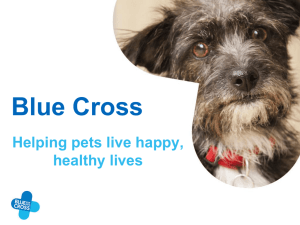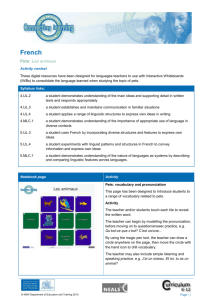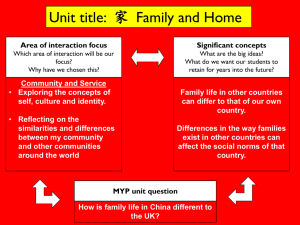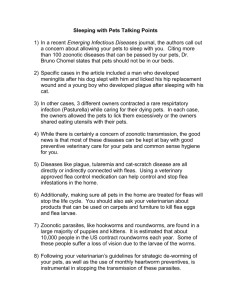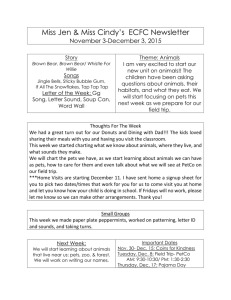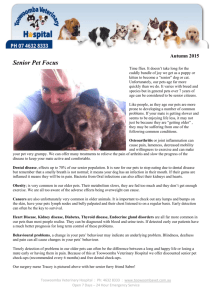German Pets: Die Haustiere
advertisement
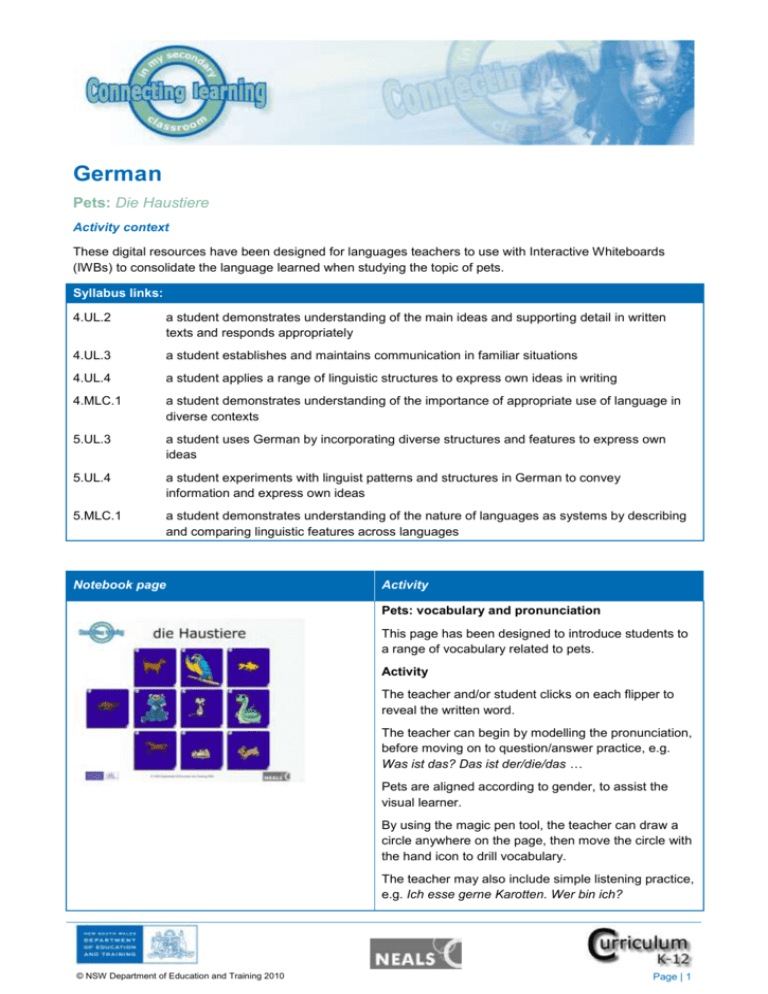
German Pets: Die Haustiere Activity context These digital resources have been designed for languages teachers to use with Interactive Whiteboards (IWBs) to consolidate the language learned when studying the topic of pets. Syllabus links: 4.UL.2 a student demonstrates understanding of the main ideas and supporting detail in written texts and responds appropriately 4.UL.3 a student establishes and maintains communication in familiar situations 4.UL.4 a student applies a range of linguistic structures to express own ideas in writing 4.MLC.1 a student demonstrates understanding of the importance of appropriate use of language in diverse contexts 5.UL.3 a student uses German by incorporating diverse structures and features to express own ideas 5.UL.4 a student experiments with linguist patterns and structures in German to convey information and express own ideas 5.MLC.1 a student demonstrates understanding of the nature of languages as systems by describing and comparing linguistic features across languages Notebook page Activity Pets: vocabulary and pronunciation This page has been designed to introduce students to a range of vocabulary related to pets. Activity The teacher and/or student clicks on each flipper to reveal the written word. The teacher can begin by modelling the pronunciation, before moving on to question/answer practice, e.g. Was ist das? Das ist der/die/das … Pets are aligned according to gender, to assist the visual learner. By using the magic pen tool, the teacher can draw a circle anywhere on the page, then move the circle with the hand icon to drill vocabulary. The teacher may also include simple listening practice, e.g. Ich esse gerne Karotten. Wer bin ich? © NSW Department of Education and Training 2010 Page | 1 Editing This page can be edited to include additional or alternative vocabulary items. Click on the double arrows in the top left of each card, then drag in a new picture or edit the text on the back of the card. Click on the double arrows to reset the activity. Sound files can also be added. Pet vocabulary: matching images This page has been designed to help students revise and consolidate vocabulary associated with pets. Activity The student identifies the pets by dragging the correct vocabulary from the list into the appropriate boxes. The teacher may also use this activity to consolidate pronunciation, only allowing the words to be dropped into the box when they have been correctly pronounced. Editing This activity can be modified by clicking on 'Edit' in the top left corner. Different images can be dragged into the boxes and the text can be altered. Pet vocabulary: matching images As for page 2 (above). Pets: focusing on genders This page has been designed to help students consolidate vocabulary and recognise genders of words. A screen shade has been placed over the vocabulary items at the bottom of the page. The teacher can choose to reveal the list by clicking on the shade and pulling it down, or keep it concealed. Activity Students can write in the relevant vocabulary using the pen tool, or the vocabulary can be dragged into the appropriate boxes from the bottom of the page. Activity This page can also be used at the end of the unit. © NSW Department of Education and Training 2010 Page | 2 Students complete the boxes without the aid of provided vocabulary, demonstrating recognition of vocabulary, correct spelling and genders. Editing Different images may be used by dragging in selected images from the gallery tab. Matching text This page has been designed to help students reinforce recognition of vocabulary, while also being aware of the spelling of words. Activity The teacher and/or student can drag and drop the vocabulary from the list into the appropriate boxes. Editing This activity can be modified by clicking on the ‘Edit’ button in the top left corner. Matching pictures to words This page has been designed to help students consolidate vocabulary related to pets. Activity Students can complete this individually, in pairs or in teams. Individually: Students click on two cards and try to match pairs. In teams: Team members take turns to click on two cards and try to match pairs. When two matching cards are found, the team is awarded a point. The winning team is the team with the most points. Activity This game may also be played as a race against the clock, with the winner finding the most pairs in the shortest amount of time. To set this up, select and add an interactive timer from the gallery tab. Editing This page can be edited to include other vocabulary items and images. The teacher may substitute images in place of English text. Click on 'Edit' and use the option to drag in up to 12 pairs of pictures, and/or type in text. To delete images and replace with text, select the 'Delete images' box on the bottom left. © NSW Department of Education and Training 2010 Page | 3 Pets: gender sort This page has been designed to help students consolidate vocabulary and recognise genders of words. Activity The student correctly identifies each animal and drags the relevant picture into the appropriate column, according to the gender. By clicking on the ‘Check’ button, instant feedback is provided. Activity This page can also be used at the end of the unit, with students identifying the pictures in writing. Editing This page can be edited to include additional or alternative images. Pets: introducing the accusative case and kein/keine This page has been designed to introduce the accusative case and the concept of kein/keine. Activity Students practise forming sentences using Ich habe … Colour coding of genders will assist in this exercise. This exercise can be expanded by including additional animal vocabulary, as required. Students can also use the same model to practise using kein in sentences, e.g. Ich habe keinen Hund. Students can then form sentences such as Ich habe eine Katze, aber ich habe keinen Hund, etc. The teacher may also consolidate this activity by using the first page in this Notebook. Oral practice: Hast du ein Haustier? This page enables students to consolidate the use of the accusative case, without the support of written structures. Activity The teacher and/or student clicks on the die to randomly select a visual prompt. The student then responds appropriately in German, using the structures already learned. Note: This activity also includes the structure Ich habe keine Haustiere. Editing This page can be modified by clicking on the double arrows at the top left of the die to change or add text or images. © NSW Department of Education and Training 2010 Page | 4 Describing animals This page is designed to introduce students to a range of adjectives describing animals. Activity The teacher can model the pronunciation or provide linked sound files. Describing animals: Matching text This page has been designed to allow students to consolidate their knowledge of adjectives used to describe pets. Activity The teacher and/or student drags and drops the vocabulary from the list into the appropriate boxes. Editing This activity can be modified by clicking on the ‘Edit’ button in the top left corner. Describing animals: anagrams This page has been designed to help students focus on the correct spelling of adjectives. Activity This activity can be completed individually or in teams. Individually: Students compete to see who can unscramble the words in the fastest time. In teams: Team members take turns to unscramble the words in the fastest time. Students can click on the 'Clue' button if assistance is needed. The activity will pause after each word. Click 'Next' to advance to the next vocabulary item. The team completing the task in the best time wins. Extra points are awarded if the activity is completed without using 'Clue'. The 'Reset' button creates a different configuration of scrambled letters for those students wishing to repeat the same activity. Editing The words and/or clues can be changed by clicking on the ‘Edit’ button in the top left-hand corner. If this activity is to be used as a competition, it can be copied onto the next page by right-clicking on the appropriate page on the page sorter tab and selecting 'Clone Page’. Team members then take turns, swapping pages accordingly. © NSW Department of Education and Training 2010 Page | 5 Describing pets: pronouns This page has been designed to teach students how to use pronouns. Colour coding will assist visual learners to associate the correct pronoun with the gender of the noun. Talking about pets: writing and speaking activity This page has been designed to consolidate language vocabulary and structures related to describing pets. Activity The teacher and/or student clicks on the 'Select' button at the bottom of the page to randomly select a pet. By clicking on the spinner, an adjective to describe the pet will also be randomly selected. Using the information provided, the student writes the sentence and/or provides an oral response. Editing To modify this page, click on the double arrows at the side of the spinner to change the spinner labels. To add or remove animal images, click on the ‘No. of images’ menu at the bottom of the page and drag the images into the desired box. Assessment strategies: The teacher: observes students responding to questions, participating in activities and interacting with each other provides direct oral feedback to the class to enhance learning supports individual students with additional explanations and feedback reinforces linguistic links and encourages students to make linguistic connections provides opportunities for summative as well as formative assessment. Assessment criteria: The student: listens actively to aid comprehension practises pronunciation to assist in oral skills develops skills in the spelling of German words participates in activities to develop vocabulary recognition demonstrates comprehension of written German develops and demonstrates oral and writing skills in context. © NSW Department of Education and Training 2010 Page | 6 The Notebook files for each student can form part of your assessment to inform your teaching and capture "point in time" learning. © NSW Department of Education and Training 2010 Page | 7
